Coffee Alternatives And Tea
How to Make Coffee Substitute From Grain
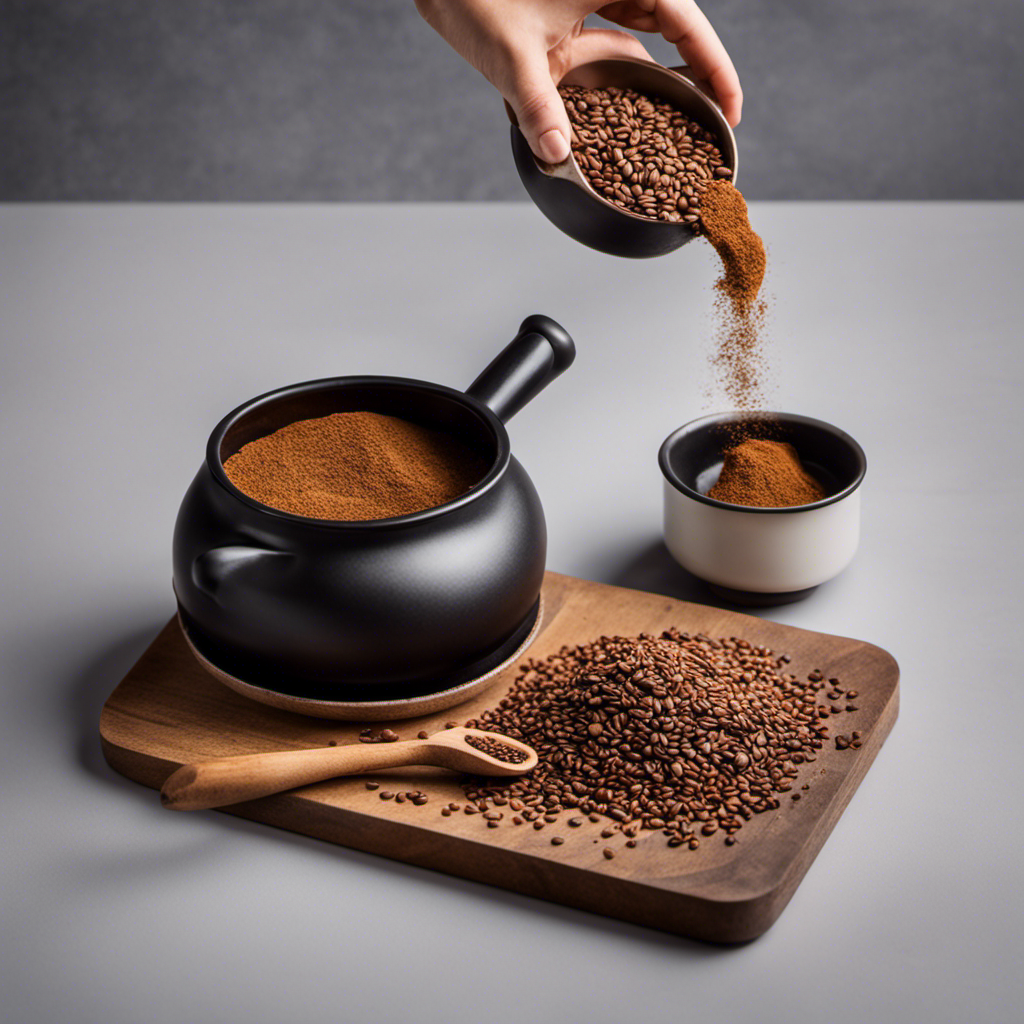
I’m going to teach you how to craft a tasty alternative to coffee using grains. This is an excellent choice for individuals wishing to reduce their caffeine intake or delve into novel taste experiences. By selecting the appropriate grains and employing simple techniques like roasting and grinding, along with incorporating natural enhancers, you’ll be able to concoct a beverage that’s both rich in flavor and fulfilling.
In this article, I’ll guide you through the process, provide tips for adjusting the strength, and share the health benefits of this alternative.
Get ready to discover the world of grain coffee substitute and elevate your morning routine.
Key Takeaways
- Grain coffee substitutes offer a wide range of flavors and can be chosen based on personal preferences.
- Roasting and grinding the grains properly is crucial for developing the desired flavor profile.
- French press brewing method is recommended for extracting maximum flavor from grain coffee substitutes.
- Proper storage and preservation techniques ensure the freshness and flavor of grain coffee substitutes for a longer period.
Choosing the Right Grain for Coffee Substitute
Now, let’s talk about how you can choose the right grain for your coffee substitute.
When it comes to choosing grain types for your coffee alternative, there are a few factors to consider. First, consider your personal preferences. Some popular grain options include barley, rye, and chicory. Each grain offers its own unique flavor profile, so it’s important to choose one that suits your taste buds.
Additionally, consider the benefits of grain coffee. Unlike traditional coffee, grain coffee is caffeine-free, making it a great option for those who are sensitive to caffeine or looking to reduce their intake. Grain coffee is also rich in antioxidants and fiber, which can support digestion and overall health.
So, when selecting your grain, keep your preferences and the benefits in mind.
Now, let’s move on to the next step: roasting and grinding the grain.
Roasting and Grinding the Grain
When it comes to roasting coffee substitute grains, it’s crucial to understand the optimal temperature for achieving the best flavor. Roasting at too high a temperature can result in a burnt taste, while roasting at too low a temperature may not bring out the desired flavors.
Additionally, the grinding method plays a significant role in the overall quality of your coffee substitute. Grinding too fine can lead to a bitter brew, while grinding too coarse may result in a weak and watery cup.
Therefore, it’s essential to consider the optimal roasting temperature and choose the right grinding method to ensure a delicious and satisfying coffee substitute experience.
Optimal Roasting Temperature
To achieve the optimal roasting temperature for your coffee substitute made from grain, you’ll want to preheat the oven to 400°F. This temperature will ensure that the grains are evenly roasted and bring out their rich flavors.
Here are the benefits of different roasting temperatures:
-
Light Roast (400-430°F): This temperature range produces a light-colored grain with a mild flavor. It retains more of the grain’s natural sweetness and acidity, resulting in a brighter cup of coffee substitute.
-
Medium Roast (430-450°F): A medium roast brings out a balanced flavor profile, with subtle notes of caramel and chocolate. It strikes a perfect balance between acidity and bitterness.
-
Dark Roast (450-480°F): At higher temperatures, the grain develops a deep, rich flavor with hints of smokiness. The dark roast is known for its bold and intense taste.
Grinding Methods and Tips
Grinding your coffee substitute into a fine powder using a burr grinder will result in a more consistent and flavorful cup of joe. When it comes to grinding techniques, there are a few key factors to keep in mind.
Firstly, adjust the grinder settings to achieve the desired coarseness or fineness. For a coffee-like texture, aim for a medium grind.
Secondly, make sure to grind in short bursts to prevent overheating the grain, which can alter the flavor. It’s also important to clean your grinder regularly to avoid any residual flavors from previous batches.
As for equipment recommendations, a burr grinder is highly recommended due to its ability to produce a consistent grind size. It ensures that all particles are of similar size, resulting in a more balanced extraction and a better-tasting coffee substitute.
Brewing Methods for Grain Coffee Substitute
When it comes to brewing grain coffee substitutes, there are several key points to consider.
First, finding the best brewing technique is crucial in extracting the optimal flavors from the grains. This could involve methods such as steeping, boiling, or using a French press.
Secondly, exploring flavor variations can add depth and complexity to your cup of grain coffee substitute. By experimenting with different ratios of grains, adding spices or sweeteners, or even blending different types of grains, you can create a unique and personalized flavor profile.
Best Brewing Techniques
One of the best brewing techniques for coffee substitute made from grain is using a French press. Here’s why:
-
Superior extraction: The French press allows for maximum contact between the grain and water, resulting in a robust and flavorful brew. This brewing method ensures that you extract all the rich flavors and aromas from the grain.
-
Versatility: The French press is a versatile brewing equipment that can be used with different types of grains to create alternative flavor profiles. Whether you prefer a nutty taste or a more earthy flavor, the French press can accommodate your preferences.
-
Ease of use: With its simple design and straightforward process, using a French press to brew grain coffee substitute is hassle-free. Just add your grain, pour hot water, wait for a few minutes, and press down the plunger. It’s that easy!
Flavor Variations and Experimentation
If you’re feeling adventurous, you can experiment with different flavors and variations when brewing your French press coffee alternative. The good news is that there are countless flavor profiles and brewing techniques to explore.
For example, you could try adding spices like cinnamon or nutmeg to your brew to create a warm and comforting flavor. Alternatively, you could experiment with different types of grains, such as barley or rye, for a unique and earthy taste. Don’t be afraid to adjust the brewing time and temperature to bring out different flavors and strengths.
Remember, the possibilities are endless, so have fun and let your taste buds guide you.
Now, let’s dive into enhancing the flavor even further with natural additives.
Enhancing Flavor With Natural Additives
To enhance the flavor of your coffee substitute, you can add natural additives such as cinnamon or vanilla. These flavorful alternatives not only enhance the taste but also provide a hint of sweetness without the need for artificial sweeteners.
Here are three natural sweeteners that can elevate the flavor of your coffee substitute:
-
Stevia: This natural sweetener comes from the leaves of the stevia plant and is known for its zero-calorie sweetness. It can be used in small amounts to add a touch of sweetness to your coffee substitute without adding any calories.
-
Honey: A natural and delicious sweetener, honey adds a unique flavor profile to your coffee substitute. It also contains antioxidants and has antimicrobial properties, making it a healthier choice compared to refined sugar.
-
Maple Syrup: Made from the sap of maple trees, maple syrup offers a rich and distinct sweetness. It contains minerals like manganese and zinc, adding nutritional value to your coffee substitute.
Tips for Adjusting the Strength of Grain Coffee Substitute
When adjusting the strength of your grain coffee substitute, you can experiment with different brewing times to find the perfect balance of flavor. The longer you steep the grains in hot water, the stronger the taste will be. If you prefer a milder flavor, reduce the brewing time. This method allows you to adjust the taste according to your preference.
Additionally, brewing time can also affect the caffeine content of the drink. The longer the grains are steeped, the more caffeine is extracted. So, if you want to reduce your caffeine intake, opt for a shorter brewing time.
By experimenting with different brewing times, you can customize your grain coffee substitute to suit your taste and caffeine needs.
Now that you know how to adjust the strength, let’s move on to the next step: storing and preserving your grain coffee substitute.
Storing and Preserving Grain Coffee Substitute
Once you’ve found the perfect balance of flavor for your grain coffee substitute, it’s important to properly store and preserve it to maintain its freshness.
Here are some preserving techniques for long-term storage:
-
Store in an airtight container: Transfer your grain coffee substitute to airtight containers to prevent exposure to moisture and air, which can lead to spoilage and loss of flavor.
-
Keep away from light and heat: Store the containers in a cool, dark place, as light and heat can degrade the quality of the grain coffee substitute over time.
-
Freeze for extended shelf life: If you want to extend the shelf life of your grain coffee substitute even further, consider freezing it in airtight freezer bags. This can help preserve its freshness for months.
Properly storing and preserving your grain coffee substitute will ensure that it stays fresh and flavorful for a longer period of time.
Now, let’s explore the health benefits of this delightful alternative to traditional coffee.
Health Benefits of Grain Coffee Substitute
Storing and preserving grain coffee substitute properly ensures that it stays fresh and flavorful for a longer period of time, allowing you to enjoy its health benefits.
Grain coffee alternatives, such as barley or chicory, have gained popularity due to their numerous health advantages. First and foremost, these substitutes are caffeine-free, making them a great option for individuals who are sensitive to caffeine or looking to reduce their intake.
Additionally, grain coffee alternatives are rich in antioxidants, which help protect the body against harmful free radicals and reduce the risk of chronic diseases.
Moreover, these substitutes are known to have a positive impact on digestion. The high fiber content in grain coffee alternatives promotes healthy digestion and can alleviate issues such as constipation.
Exploring Different Varieties of Grain for Coffee Substitute
When it comes to exploring different varieties of grain for a coffee substitute, there are a multitude of unique options to consider.
Each type of grain brings its own distinct flavor profile and characteristics, allowing for a rich and diverse range of choices.
Additionally, grains offer numerous health benefits, such as being high in fiber, vitamins, and minerals, which can contribute to improved digestion and overall well-being.
Unique Grain Options
There are a few unique grain options you can try as a coffee substitute. These grains not only provide a rich and satisfying flavor but also offer various health benefits.
Here are three options to consider:
-
Barley: Barley is a versatile grain that can be roasted and ground to create a coffee-like beverage. It has a nutty and slightly bitter taste, similar to traditional coffee. Barley is rich in antioxidants and fiber, promoting better digestion and heart health.
-
Chicory: Chicory root has been used as a coffee substitute for centuries. It has a dark and robust flavor that closely resembles coffee. Chicory is known for its anti-inflammatory properties and may help in regulating blood sugar levels.
-
Dandelion Root: Dandelion root coffee is gaining popularity for its unique taste and potential health benefits. It has a slightly bitter and earthy flavor. Dandelion root is rich in vitamins and minerals, such as vitamin C and potassium, and may aid in detoxification and liver health.
Health Benefits of Grains?
Incorporating these different grains into your routine can provide you with numerous health benefits. Grains are packed with nutritional value, containing essential vitamins, minerals, and fiber. They are low in fat and cholesterol, making them a healthy choice for overall well-being.
Whole grains, such as oats and quinoa, are particularly beneficial as they retain their bran and germ, which are rich in nutrients. These grains can help regulate blood sugar levels, lower cholesterol, and improve digestion. The fiber in grains promotes regular bowel movements and helps with weight management.
By incorporating a variety of grains into your diet, you can enjoy their diverse nutritional benefits and support a healthy digestive system.
Now, let’s explore how blending grain with other ingredients can create unique coffee flavors.
Blending Grain With Other Ingredients for Unique Coffee Flavors
To create unique coffee flavors, you can blend grain with other ingredients. Blending techniques and alternative brewing methods can elevate the taste and aroma of your coffee substitute.
Here are three ways to experiment with blending grain and other ingredients:
-
Roasting: Roast the grains before grinding them to enhance their flavor profile. This will add depth and complexity to your coffee substitute.
-
Flavor Infusions: Add spices like cinnamon, nutmeg, or cardamom to the grains during the brewing process. These aromatic additions will infuse the coffee substitute with delightful flavors.
-
Sweeteners and Creamers: Experiment with different sweeteners like honey or maple syrup, and try adding a splash of plant-based milk to create a creamy texture.
Serving Suggestions and Recipes for Grain Coffee Substitute
Now that we’ve explored the art of blending grain with other ingredients to create unique coffee flavors, let’s delve into some serving suggestions and recipes for grain coffee substitute.
Whether you prefer a hot cup of grain coffee in the morning or a refreshing iced version in the afternoon, there are plenty of options to suit your taste buds.
For a classic cup of grain coffee, simply brew it using a coffee maker or French press and enjoy it black or with your favorite milk and sweetener. You can also get creative and add flavors like cinnamon or vanilla extract for an extra kick.
As for health benefits, grain coffee substitutes are rich in antioxidants, fiber, and essential minerals, making them a healthier alternative to traditional coffee.
Frequently Asked Questions
Can I Use Any Type of Grain to Make Coffee Substitute, or Are There Specific Grains That Work Best?
I can use any type of grain to make a coffee substitute, but there are specific grains that work best. I will need to learn about roasting techniques and brewing equipment to ensure the best results.
How Long Should I Roast and Grind the Grain to Achieve the Best Flavor in My Coffee Substitute?
To achieve the best flavor in my coffee substitute, I need to consider the roasting techniques and grinding methods. It’s important to find the right balance to bring out the desired flavors and aromas.
Are There Any Brewing Methods That Are Particularly Well-Suited for Grain Coffee Substitute?
There are various brewing techniques that work well with grain coffee substitutes. I’ve found that using a French press or a pour-over method yields a rich and flavorful cup. Taste comparisons have shown that these methods bring out the best flavors in the grain.
What Are Some Natural Additives I Can Use to Enhance the Flavor of My Grain Coffee Substitute?
To enhance the flavor of grain coffee substitute, I recommend using natural additives like cinnamon, vanilla extract, or cocoa powder. These ingredients add depth and richness to the taste, making for a more satisfying coffee alternative.
Are There Any Health Benefits Associated With Drinking Grain Coffee Substitute, or Is It Purely a Flavor Alternative to Regular Coffee?
There are health benefits associated with drinking grain coffee substitute, making it more than just a flavor alternative to regular coffee. It can provide antioxidants, fiber, and other nutrients that contribute to overall well-being.
Conclusion
In conclusion, making coffee substitute from grain is not only a healthy alternative, but it also offers a wide variety of flavors and options.
Did you know that according to a study published in the Journal of Agricultural and Food Chemistry, grain coffee substitutes contain higher levels of antioxidants compared to traditional coffee? This interesting statistic highlights the potential health benefits of choosing grain coffee substitutes.
By following the steps outlined in this article, you can easily enjoy a delicious and nutritious cup of grain coffee substitute.
So why not give it a try and explore the world of grain coffee today?
Noah, the Editor-in-Chief at Cappuccino Oracle, plays a pivotal role in shaping the voice and vision of our renowned platform. With an unwavering passion for coffee, coffee alternatives, and tea, Noah leads Cappuccino Oracle towards new horizons in the realm of coffee journalism.
Beyond his professional responsibilities, Noah serves as a mentor and guiding force for his team. His dedication to journalistic excellence and genuine love for coffee, coffee alternatives, and tea continue to inspire and motivate the Cappuccino Oracle family. In the ever-evolving world of these beverages, Noah’s leadership ensures that our platform remains at the forefront, delivering enlightening and enjoyable content to our readers worldwide.
Coffee Alternatives And Tea
The ‘Lazy Person’s Energy Drink’ That’s Taking Over Office Kitchens
Unlock the secrets behind the ‘lazy person’s energy drink’ that’s revolutionizing office kitchens—what are its effects on productivity and wellness?
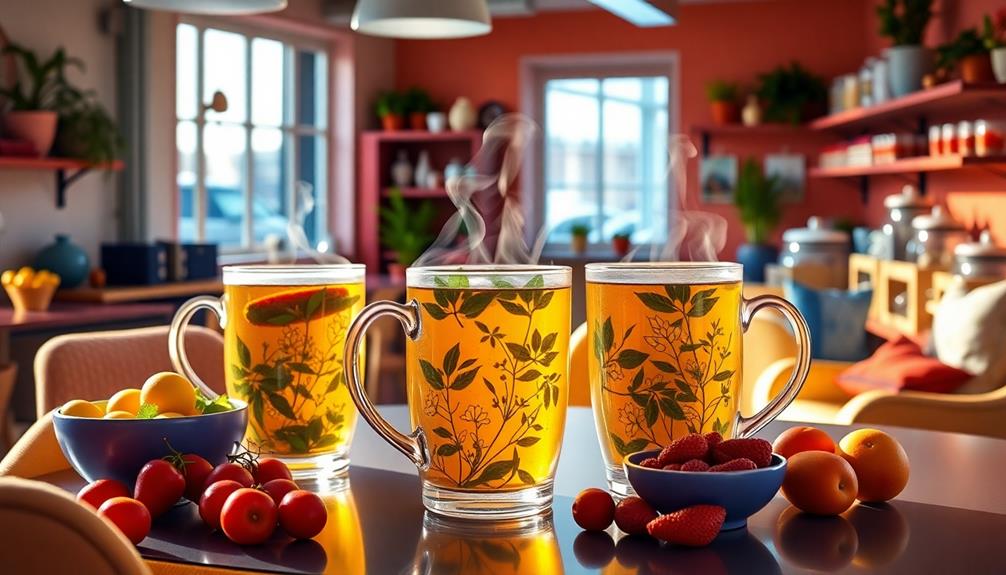
The 'lazy person's energy drink' is dominating office kitchens, especially among young professionals seeking a quick productivity boost. These drinks offer convenience and are ready-to-drink, making them perfect for busy workdays. Packed with caffeine, B vitamins, and low-calorie ingredients, they provide the energy you need without the hassle. With a focus on both flavor and health, options are evolving to cater to health-conscious consumers. As you navigate these choices, you'll find varying perceptions and trends surrounding energy drinks in workplace culture. Keep exploring to discover more about the impact these beverages have on office life.
Key Takeaways
- 'Lazy Person's Energy Drinks' offer quick energy boosts with convenient packaging, perfect for busy office environments.
- These drinks typically contain caffeine, B vitamins, and natural ingredients, catering to health-conscious consumers.
- Unique flavors often feature tropical fruits and herbs, appealing to a diverse range of taste preferences.
- Low-calorie and sugar-free options are gaining popularity, reflecting a shift towards healthier beverage choices in workplaces.
- The rise of these drinks aligns with younger professionals' demand for convenient, functional beverages in office kitchens.
Rise of Energy Drinks in Offices
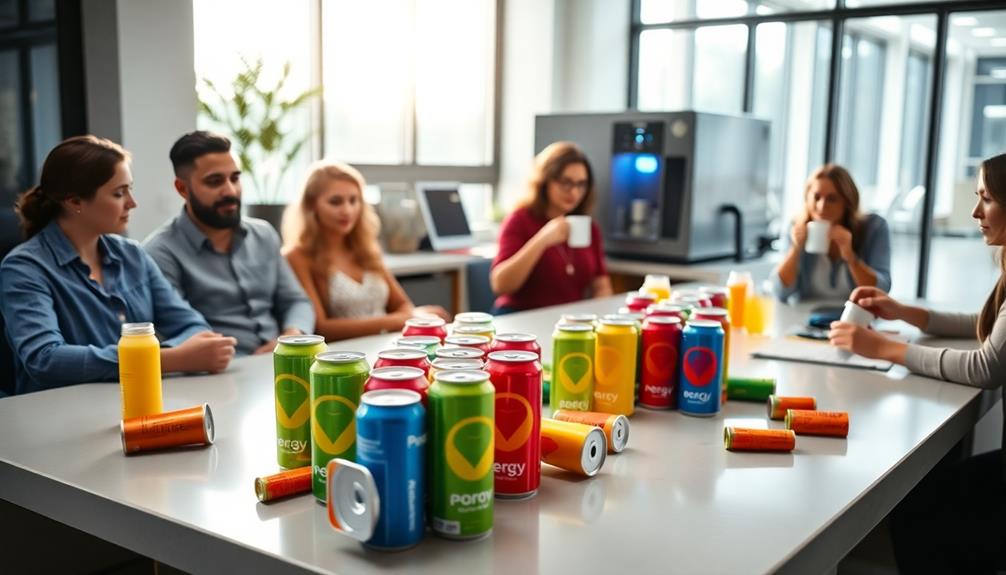
In today's fast-paced work environment, energy drinks have surged in popularity among young professionals, especially those aged 18-34. You might've noticed that brands like Red Bull and Monster are now staples in office kitchens, often replacing traditional coffee and tea.
Many workplaces stock energy drinks alongside snacks, catering to the demand for quick boosts in energy and mental alertness. The rise of energy-efficient systems, such as commercial grade heat pumps, parallels this trend, as both aim to enhance productivity and comfort in the workplace.
The global energy drink market was valued at approximately $86 billion in 2022, and it's projected to keep growing. This indicates a significant trend in workplace consumption, driven by young adults seeking efficient ways to stay energized.
You'll likely find that health-conscious options, such as sugar-free and organic energy drinks, are gaining traction too, reflecting a shift in preferences towards healthier choices.
However, the perception of energy drinks in offices can vary. Some workplace cultures embrace these beverages as energizing alternatives, while others take a more conservative stance against their consumption.
As you navigate your workday, consider how the rise of energy drinks influences your productivity and overall well-being in this dynamic environment.
Characteristics of 'Lazy Person's Energy Drink'
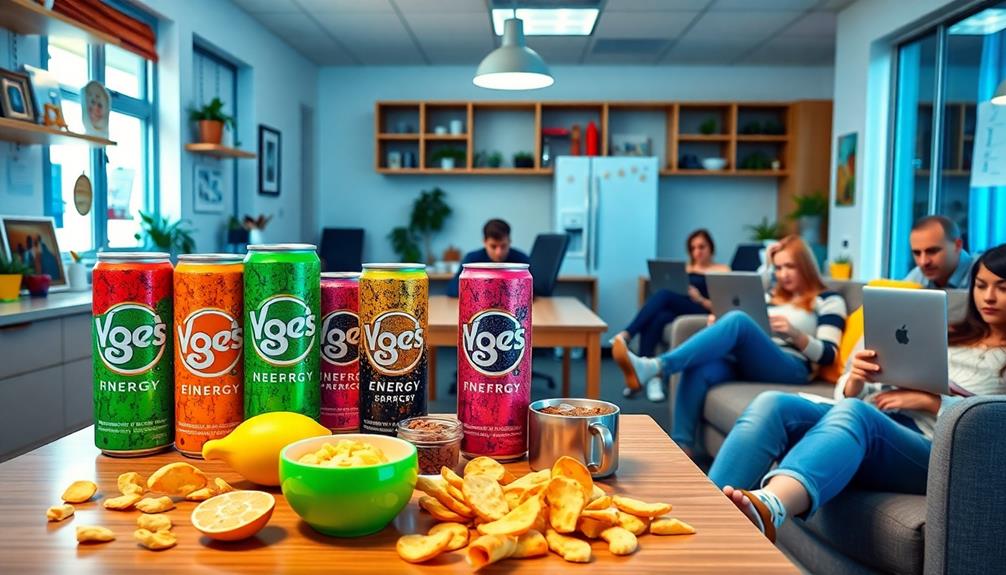
Lazy Person's Energy Drinks are designed for those who crave convenience without sacrificing energy. These ready-to-drink beverages are perfect for busy office workers like you, offering a quick energy boost without any preparation.
You'll appreciate the blend of caffeine, B vitamins, and natural ingredients that many of these drinks provide, making them a functional choice for your workday. Additionally, some energy drinks incorporate unique combinations of tropical fruits and herbs for enhanced flavor profiles, setting them apart from traditional options.
What sets these energy drinks apart is their focus on health and wellness. You'll find a variety of low-calorie and sugar-free options, catering to health-conscious consumers who want to maintain their energy levels without the guilt.
As the energy drink market continues to grow—valued at approximately $86 billion in 2022—it's clear that convenience is key.
Moreover, brands are now crafting flavors and formulations that align with your preferences, incorporating organic ingredients or additional functional benefits. This trend is especially popular among younger demographics who seek more than just a caffeine hit.
Whether you're looking for a revitalizing flavor or a specific health benefit, Lazy Person's Energy Drinks have you covered, making them a staple in today's office kitchens.
Ingredients Behind the Convenience
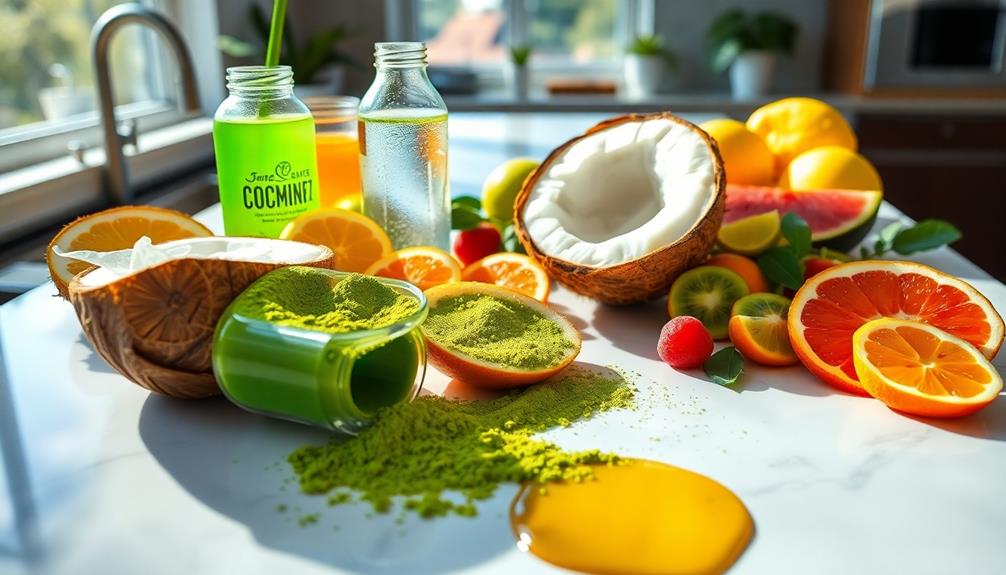
Convenience isn't just about easy access; it's also about the thoughtful ingredients packed into each can of these energy drinks. You'll often find caffeine content ranging from 70 to 200 mg per serving, offering a quick energy boost without any preparation needed. This makes it perfect for those hectic workdays when you need a lift.
Furthermore, the caffeine in these drinks can enhance athletic performance and improve focus, similar to coffee's health benefits. Many of these drinks also include taurine, an amino acid that might enhance your exercise performance and aid in recovery during your busy schedule. B vitamins are another common addition, playing a significant role in energy metabolism by converting sugars into usable energy for your body.
However, be mindful of the sugar content, which averages around 54 grams per can. While this adds to the instant energy kick, it raises concerns for long-term consumption.
On the brighter side, natural ingredients like green tea extract and nootropics are becoming popular, promoting focus and cognitive function without the jitters often associated with higher caffeine levels.
In short, these carefully chosen ingredients blend convenience with a quick energy boost, making them a staple in many office kitchens.
Health Implications and Risks

When you reach for that energy drink, it's essential to take into account the potential health risks involved.
High caffeine levels can lead to heart issues and anxiety, while excessive sugar can result in obesity and diabetes.
Additionally, certain health conditions may exacerbate these risks, making it important to consult healthcare professionals for tailored advice on treatment methods.
Mixing these drinks with alcohol only compounds the dangers, making it imperative to stay informed about what you're consuming.
Caffeine Overconsumption Risks
Caffeine can be a double-edged sword; while it offers a quick boost of energy, overconsumption poses serious health risks. If you're downing multiple caffeinated energy drinks daily, you might be flirting with health complications. The recommended daily limit for caffeine is around 400 mg for most adults, and exceeding this can lead to insomnia, increased heart rate, and heightened anxiety.
Additionally, chronic inflammation may be exacerbated by poor dietary choices often associated with high caffeine consumption, making it essential to evaluate anti-inflammatory options like herbal remedies in your diet.
Excessive intake, especially from energy drinks, has been linked to severe cardiovascular issues and even documented cases of caffeine-related deaths and seizures. You mightn't realize it, but regularly consuming these drinks can also contribute to obesity and insulin resistance, putting you at risk for metabolic disorders.
Mixing energy drinks with alcohol can mask intoxication effects, pushing you toward binge drinking, which brings its own set of dangers.
Additionally, long-term high caffeine consumption can create dependency, leading to withdrawal symptoms like headaches and fatigue when you try to cut back.
Sugar-Related Health Concerns
Many energy drinks not only pack a caffeine punch but also load you up with sugar, which can lead to serious health problems. If you're consuming these drinks regularly, you might want to reflect on the sugar-related health concerns that come along with them.
Additionally, excessive sugar intake can contribute to increased cholesterol levels, which may elevate the risk of heart disease over time, especially if you have pre-existing conditions ice cream & cholesterol.
Here are three key issues you should be aware of:
- Obesity and Diabetes Risk: Many energy drinks contain around 54 grams of sugar per can, far exceeding the American Heart Association's daily limit. This excessive intake can lead to obesity and increase your risk of type 2 diabetes.
- Dental Problems: The high sugar content, combined with the acidic nature of these beverages, can cause significant dental issues. You might experience cavities and enamel erosion if you indulge too often.
- Cardiovascular Risks: The combination of high sugar and caffeine can elevate your risk of adverse cardiovascular events, especially if you have pre-existing health conditions.
Being mindful of your energy drink consumption isn't just about caffeine; it's crucial to reflect on the sugar-related health concerns that come with it. Your health deserves better!
Mixed Beverage Dangers
Mixing energy drinks with alcohol can create a dangerous cocktail that masks the effects of intoxication, making you more likely to overindulge. When you consume energy drinks alongside alcohol, the high caffeine content may lead you to underestimate your level of drunkenness. This can result in increased alcohol consumption, raising the risk of accidents and alcohol-related harm.
Additionally, the high sugar content in these energy drinks can have negative health implications, similar to those seen in individuals consuming excessive amounts of processed foods, which can result in chronic diseases over time.
Moreover, the combination puts additional strain on your cardiovascular system. The high caffeine intake can cause an increased heart rate, leading to potentially dangerous heart issues. On top of that, energy drinks are often loaded with sugar, which can contribute to obesity, diabetes, and dental problems when consumed excessively.
You should also be aware that combining energy drinks and alcohol can heighten anxiety levels and potentially lead to addiction due to the stimulating effects of caffeine.
Regulatory bodies specifically warn vulnerable populations, like children and pregnant women, against energy drinks due to these health risks. It's crucial to evaluate these dangers before mixing beverages, as the consequences can be severe and far-reaching.
Prioritizing your health means making informed choices about what you drink.
Popular Brands and Offerings
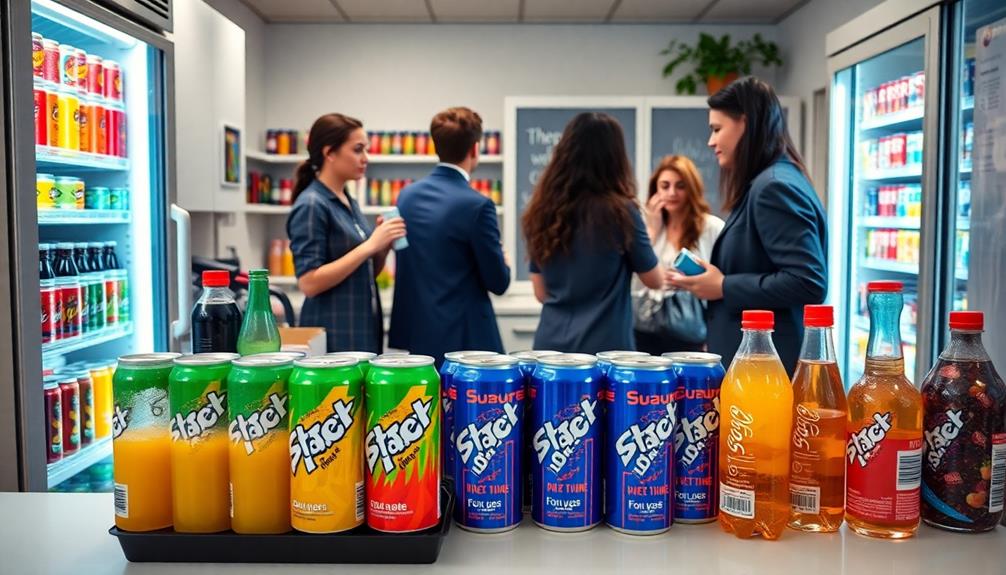
In the bustling world of energy drinks, popular brands like Red Bull, Monster, and Rockstar lead the charge, each offering unique flavors and formulations to suit your taste. Significantly, energy drinks have become a staple in many workplaces, similar to how top-rated vacuums are essential for maintaining a clean environment.
Red Bull alone sold over 7.9 billion cans in 2020, showcasing its dominance. Meanwhile, Monster Energy stands out for its extensive variety, catering to diverse consumer preferences.
Here are a few key offerings you might find appealing:
- Monster Energy: With flavors like Ultra Sunrise and Mango Loco, it provides options for everyone, including sugar-free varieties that are gaining traction among health-conscious consumers.
- Red Bull: Known for its classic taste, it's also expanded into flavors like Watermelon and Tropical—perfect for a revitalizing energy boost.
- Emerging Brands: Watch for newer brands focusing on organic and natural formulations, including lighter, seltzer-style energy drinks that appeal to those seeking a more health-conscious option.
The energy drink market, valued at approximately $86 billion in 2022, shows no signs of slowing down, indicating that these beverages continue to resonate with various demographics.
Whether you need a quick pick-me-up or a revitalizing drink, there's something out there for everyone.
Office Culture and Beverage Choices
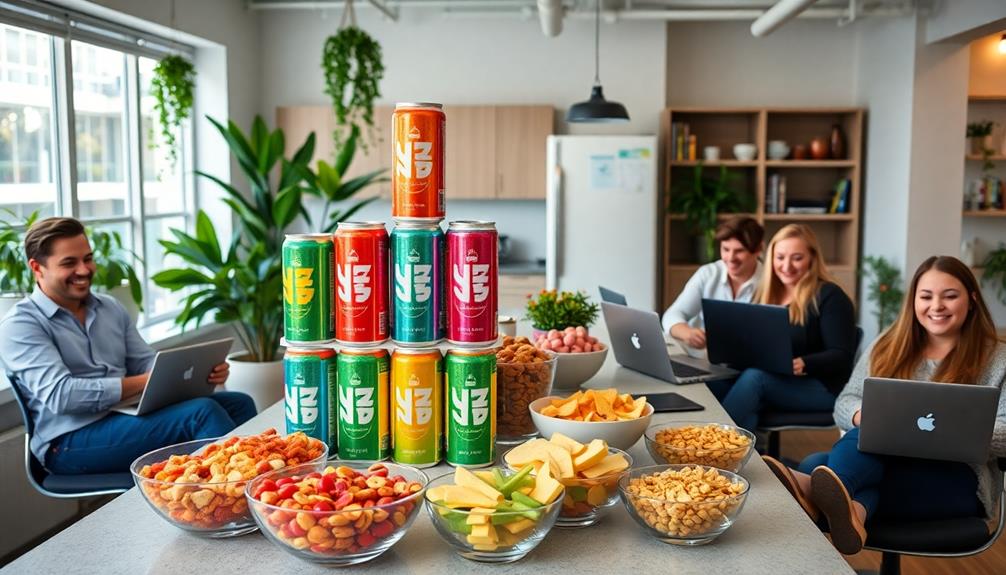
In the office, your choice of beverage can say a lot about you. While energy drinks might give you the boost you need, they can also spark conversations about professionalism and health trends among coworkers.
The impact of beverage choices can even extend to discussions about workplace productivity and engagement, as seen in trends towards personalized learning experiences that cater to individual needs.
Depending on your workplace culture, you might find yourself maneuvering the fine line between convenience and conformity in your drink selection.
Beverage Perception in Offices
Office culture shapes how beverages are perceived, and energy drinks often face scrutiny compared to the more accepted coffee. Energy drinks can also be seen as a sign of needing a quick fix rather than a sustainable energy source, contrasting with the notion of a well-planned budget that promotes long-term productivity.
Many employees feel pressured to conform to beverage norms to maintain a professional image. Here are three reasons why energy drinks might be viewed differently in the workplace:
- Professionalism: Coffee is seen as a staple in office culture. Energy drinks, on the other hand, can be viewed as less serious, leading to judgments about your work ethic.
- Appearance: Their resemblance to alcoholic beverages can raise eyebrows. Colleagues might question your choice, associating it with a lack of professionalism or discipline.
- Cultural Variability: Acceptance varies by industry. Some workplaces embrace energy drinks for boosting productivity, while others maintain a conservative stance, leading to mixed perceptions among employees.
Younger adults, particularly those aged 18-34, are more likely to consume energy drinks, with 24% to 57% reporting recent use.
Despite this, the stigma surrounding them often prompts individuals to conceal their beverage choices, fearing negative perceptions that could affect their standing in the office.
Professional Image Considerations
Beverage choices in the workplace can considerably shape how others perceive your professional image. While energy drinks may be popular, they often evoke skepticism and judgment. Colleagues might view them as unprofessional compared to traditional options like coffee and tea. This perception can lead to misunderstandings about your professionalism and health management.
Different office cultures have varying norms regarding beverage choices. In some environments, energy drinks are accepted for their performance benefits, while others enforce stricter standards. Social dynamics also play a role; you might feel pressure to opt for healthier beverages to align with colleagues.
When it comes to first impressions, especially during interviews, it's essential to reflect on your drink. Consuming energy drinks can negatively impact how interviewers perceive your professionalism.
Here's a quick comparison to illustrate these ideas:
| Beverage Type | Professional Perception |
|---|---|
| Coffee | Traditional, widely accepted |
| Tea | Calm, sophisticated |
| Energy Drink | Skeptical, potentially unprofessional |
| Water | Healthy, neutral |
| Herbal Tea | Relaxing, thoughtful |
Choosing your beverage wisely can help maintain a positive professional image.
Cultural Norms Around Drinks
While some workplaces embrace energy drinks as a quick pick-me-up, others view them with skepticism, reflecting broader cultural norms around drink choices. Your office culture can greatly influence how you're perceived based on what you choose to drink. In conservative environments, energy drinks might be frowned upon, while tech companies are often more lenient.
This dynamic can be further complicated by the privacy considerations surrounding the marketing of such beverages, as the perception of energy drinks is shaped by both personal and societal factors.
Here are three factors shaping these cultural norms:
- Professional Image: Drinking energy drinks can lead to misunderstandings about your professionalism, especially in traditional fields.
- Generational Stigma: Energy drinks are often associated with younger generations, leading to judgments based on age and beverage choices.
- Social Dynamics: Workplace social pressures can push you toward healthier options like water, making energy drinks seem less acceptable.
As you navigate these norms, it's crucial to reflect on how your choices may impact perceptions. While staying hydrated with water is always a solid choice, be mindful of how energy drinks may color your colleagues' views of you.
Ultimately, your drink selection can play a surprising role in shaping your professional image.
Consumer Demographics and Trends
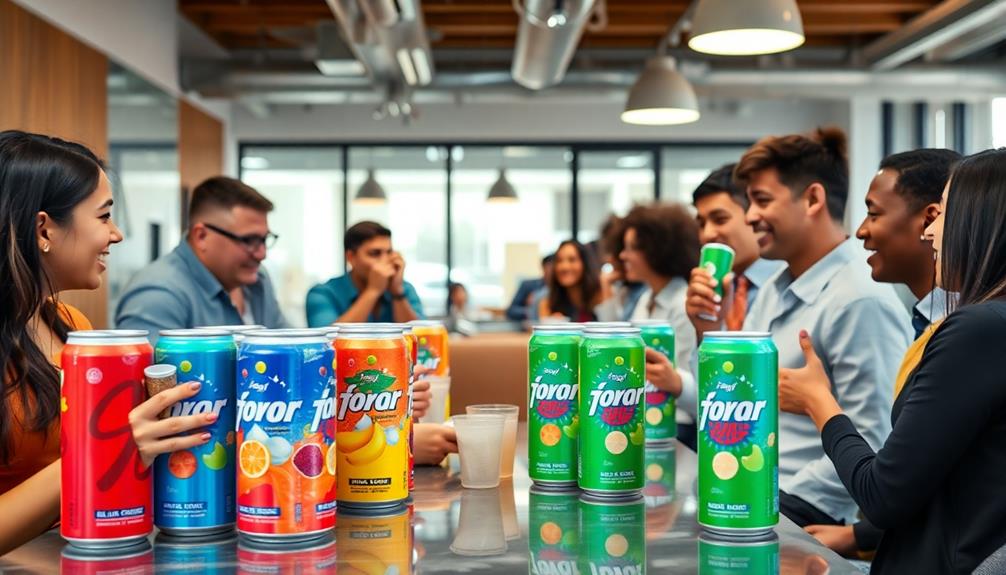
In recent years, the consumer landscape for energy drinks, particularly those marketed as 'lazy person's energy drinks,' has shifted dramatically. Young adults aged 18-34 now represent the largest segment of this market, with their consumption rates steadily increasing.
As you navigate your options, you might notice a strong preference for low-calorie and sugar-free varieties, reflecting a broader health-conscious trend among your peers.
Additionally, the rise of functional beverages emphasizes the growing consumer interest in wellness-oriented products that offer more than just a quick energy boost. You're likely to see brands that provide added health benefits gaining popularity, as they align with your desire for healthier alternatives.
Social media plays a vital role in shaping your purchasing decisions and brand loyalty, driving you towards companies that resonate with your lifestyle values, including sustainability.
Moreover, as energy drinks find their way into more office kitchens, it signals a significant shift in workplace beverage culture. Many young adults, like you, now view these drinks as convenient alternatives to traditional coffee or tea, making them a staple in many modern work environments.
Perceptions of Energy Drinks at Work

As energy drinks become more common in workplaces, perceptions surrounding their consumption have evolved. While some view them as a quick boost, others see them as less professional than traditional options like coffee or tea. This cultural divide affects how you're perceived when reaching for that can during a busy workday.
Here are three common perceptions about energy drinks at work:
- Health Concerns: Colleagues might scrutinize your choice, associating energy drinks with poor health management.
- Alcohol Misconceptions: The appearance of energy drinks can resemble alcoholic beverages, leading to misunderstandings about your drinking habits in a professional setting.
- Generational Differences: Younger adults (ages 18-34) tend to consume energy drinks more frequently, impacting how different generations judge each other's beverage choices.
In many workplaces, drinking energy drinks during interviews is discouraged. First impressions matter, and your choice of beverage can influence how potential employers perceive you.
Understanding these perceptions can help you navigate the complexities of beverage choices in a professional environment while ensuring you still get that much-needed energy boost.
Tips for Responsible Consumption
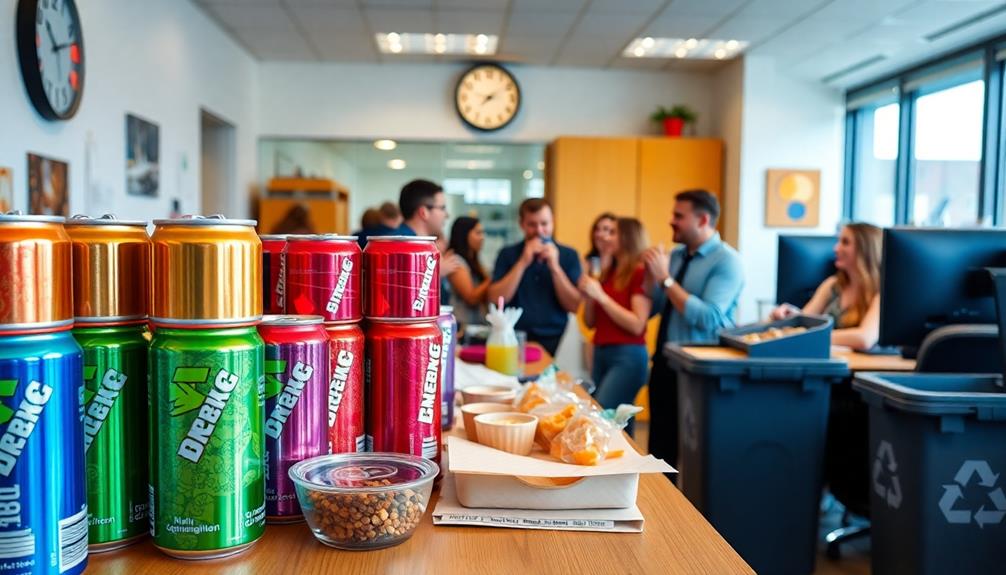
Energy drinks can provide a quick pick-me-up, but responsible consumption is key to reaping their benefits without the drawbacks. To start, limit your intake to just one can per day. This keeps you within the recommended caffeine limit of 400 mg for most adults, helping you avoid issues like insomnia and an increased heart rate.
When choosing your energy drink, opt for sugar-free or low-calorie options. Many drinks are loaded with sugar, which can contribute to obesity and raise your risk of diabetes.
It's also vital to avoid mixing energy drinks with alcohol; this combination can mask intoxication effects and lead to risky behaviors.
Pay attention to how your body reacts after consuming energy drinks. If you notice increased anxiety or heart palpitations, consider reducing your consumption or switching to drinks with lower caffeine per serving.
Finally, stay informed about the ingredients in your chosen beverage. Not all energy drinks are created equal, and some may contain additives with unknown health effects.
Frequently Asked Questions
What Energy Drink Went Out of Business?
Several energy drinks have gone out of business, like Hype Energy in 2020 and Freaky Energy in 2018. They struggled with competition and low sales, proving the market's challenges for new and existing brands.
What Energy Drink Company Got Sued?
You might've heard that Monster Beverage Corporation got sued in January 2023. The lawsuit claims they misled consumers about the health effects of their energy drinks, particularly regarding high caffeine content and associated risks.
What Energy Drinks to Stay Away From?
You wouldn't want to sip on energy drinks like Monster or Red Bull, packed with excessive sugar and caffeine. They can spike anxiety and lead to health issues, so steer clear for better wellbeing!
Is It Safe to Drink Lipovitan Every Day?
Drinking Lipovitan every day isn't recommended. It can lead to increased heart rate, anxiety, and potential addiction due to high caffeine. Moderation is key, so consider your health and daily caffeine limits before indulging.
Conclusion
When it comes to energy drinks, remember: "All that glitters is not gold." While the 'lazy person's energy drink' offers a quick boost in office kitchens, it's vital to be mindful of what you're consuming. Balance convenience with health by understanding the ingredients and potential risks. By making informed choices, you can enjoy that extra energy without compromising your well-being. So, next time you reach for that can, think twice and sip smart!
In the vast and diverse world of coffee, coffee alternatives, and tea, Olivia has found her calling. As an author and a dedicated coffee and tea aficionado, her work for Cappuccino Oracle reflects her profound love and understanding of the intricate complexities found within these beverages. Olivia’s passion for the subject serves as both a catalyst for her creativity and a connection point with her audience.
Olivia’s appreciation for coffee, coffee alternatives, and tea blossomed at an early age. She discovered that these beverages invigorated her senses and stimulated her creative spirit. From the nuanced flavors of single-origin roasts to the captivating narratives intertwined with coffee, coffee alternatives, and tea trade and culture, Olivia found an unlimited source of inspiration in her daily cup.
Her love for these beverages and her talent for storytelling eventually converged at Cappuccino Oracle. As an author, Olivia’s mission is to illuminate the intricate tapestry that makes up the world of coffee, coffee alternatives, and tea. Her articles span a diverse range of topics, encompassing everything from the unique flavors of different brews to the sociocultural history intertwined with their cultivation and consumption.
Turmeric Tea
What Kombucha Tea Is Good for Gerd
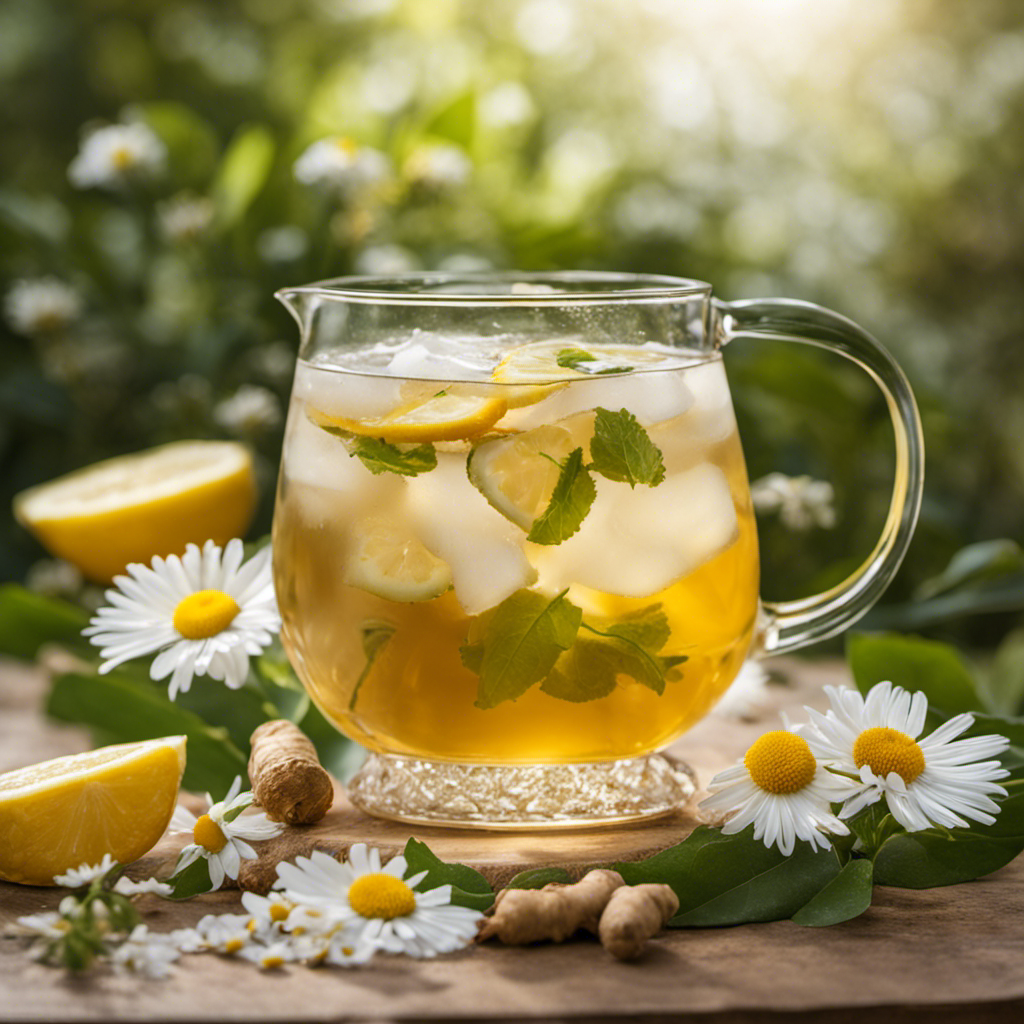
As someone who deals with GERD, I understand the challenge of finding effective natural remedies. I was excited to find out about how **kombucha tea** could help alleviate GERD symptoms. If you want to learn more about this natural remedy, keep reading!
In this article, we’ll explore the science behind how kombucha tea can soothe GERD and offer relief. We’ll also discuss how to choose the right kombucha tea and ways to incorporate it into your GERD diet.
Get ready to brew some delicious and potentially soothing kombucha tea for your GERD!
Key Takeaways
- Kombucha tea can relieve symptoms of GERD, such as heartburn and acid reflux.
- Choosing the right kombucha tea for GERD relief involves considering soothing flavors like ginger, lemon, and chamomile, as well as low sugar and minimal added ingredients.
- Kombucha tea soothes GERD symptoms by balancing stomach acidity, reducing acid reflux, and improving digestion with its beneficial bacteria and enzymes.
- When incorporating kombucha tea into a GERD diet, it is important to monitor its effects on symptoms, consider individual responses, and take into account factors such as acidity levels, sugar content, and personal tolerance.
The Benefits of Kombucha Tea for GERD
Kombucha tea can help relieve symptoms of GERD, such as heartburn and acid reflux. The benefits of consuming kombucha tea for GERD are supported by its health effects on the digestive system.
Kombucha is a fermented beverage that contains probiotics, which are beneficial bacteria that promote gut health. These probiotics can help restore the balance of bacteria in the digestive tract, reducing symptoms of GERD.
Additionally, kombucha tea is a natural source of organic acids, such as acetic acid and gluconic acid, which can help regulate stomach acidity and prevent the excessive production of stomach acid that leads to heartburn and acid reflux.
Overall, incorporating kombucha tea into your diet can have positive effects on GERD symptoms and improve your overall digestive health.
Choosing the Right Kombucha Tea for GERD Relief
When selecting the right option, make sure to consider the flavors and ingredients that may aggravate your GERD symptoms. It’s important to find kombucha flavors that are soothing and gentle on the digestive system. Some flavors that are known to provide relief for GERD sufferers include ginger, lemon, and chamomile. These flavors have anti-inflammatory properties and can help soothe the lining of the esophagus. When looking for kombucha brands, it’s best to choose ones that are low in sugar and have a minimal amount of added ingredients. Some popular brands that cater to GERD sufferers include GT’s Living Foods, Health-Ade, and Brew Dr. Kombucha. These brands offer a variety of flavors that are suitable for individuals with GERD.
| Brand | Flavors for GERD Relief |
|---|---|
| GT’s Living Foods | Ginger, Lemon |
| Health-Ade | Ginger, Lemon |
| Brew Dr. Kombucha | Ginger, Chamomile |
| Synergy | Ginger, Lemon |
| Kevita | Lemon, Chamomile |
How Kombucha Tea Can Soothe GERD Symptoms
If you’re struggling with GERD, it’s worth exploring how kombucha can provide relief for your symptoms.
Kombucha tea is known for its many health benefits, including its potential to soothe GERD symptoms. The fermentation process of kombucha produces organic acids, such as acetic acid and gluconic acid, which can help balance the pH levels in the stomach and reduce acid reflux.
Additionally, kombucha contains beneficial bacteria and enzymes that can improve digestion and promote a healthy gut.
To make kombucha tea at home, you’ll need a SCOBY (symbiotic culture of bacteria and yeast), black or green tea, sugar, and filtered water. Simply brew the tea, add sugar, cool it down, and let the SCOBY ferment the mixture for about 7-14 days.
Enjoy your homemade kombucha tea and potentially find relief for your GERD symptoms.
Incorporating Kombucha Tea Into Your GERD Diet
To incorporate it into your GERD diet, try drinking kombucha in small amounts and monitoring how it affects your symptoms. Kombucha tea can play a role in managing GERD symptoms due to its potential beneficial effects on gut health. However, it is important to note that individual responses may vary, so it is essential to listen to your body and adjust accordingly. Here is a table outlining the potential benefits and considerations of incorporating kombucha tea into your GERD diet:
| Potential Benefits | Considerations |
|---|---|
| Probiotic properties | Acidity levels |
| Antioxidant content | Sugar content |
| Potential anti-inflammatory effects | Caffeine content |
| Improved digestion | Personal tolerance |
| Hydration | Quality and safety of the tea |
Incorporating kombucha tea into your GERD diet can be a personal choice based on your individual needs and preferences. It is always recommended to consult with a healthcare professional or registered dietitian before making any significant changes to your diet.
Tips for Brewing Kombucha Tea for GERD Relief
Brewing kombucha at home can be a cost-effective way to customize the flavors and control the ingredients for your GERD relief.
When it comes to brewing techniques, it’s important to follow proper sanitation practices to prevent contamination. Start by brewing a batch of black or green tea, then add sugar and a SCOBY (Symbiotic Culture of Bacteria and Yeast).
Fermentation typically takes around 7-14 days, but it’s essential to taste-test regularly to achieve the desired acidity. To enhance the flavor of your kombucha for GERD relief, consider incorporating ingredients like ginger or chamomile, known for their soothing properties.
Keep in mind that some flavors, like citrus or spicy ones, may trigger GERD symptoms in some individuals. Experiment with different combinations to find what works best for you.
Frequently Asked Questions
Can Kombucha Tea Completely Cure Gerd?
While kombucha tea has been praised for its potential health benefits, it is important to note that it is not a replacement for medication for GERD. Additionally, some individuals may find that kombucha exacerbates their GERD symptoms.
Can I Drink Kombucha Tea if I Am on Medication for Gerd?
Yes, you can drink kombucha tea while taking medication for GERD. However, it is important to consult with your doctor to ensure that kombucha is a suitable addition to your GERD treatment plan.
Is It Safe to Drink Kombucha Tea if I Have Other Digestive Disorders?
I wondered if it was safe to drink kombucha tea with my other digestive disorders. I researched its effects on digestive disorders and found potential risks. I’ll share what I discovered.
How Much Kombucha Tea Should I Drink Daily for GERD Relief?
For optimal GERD relief, I suggest drinking a daily dosage of kombucha tea. The best time to drink it would be before meals to aid digestion. However, consult with a healthcare professional for personalized advice.
Are There Any Potential Side Effects of Drinking Kombucha Tea for Gerd?
There are potential risks and long-term effects of drinking kombucha tea for GERD. It’s important to consider these before incorporating it into your routine.
Conclusion
In conclusion, after exploring the benefits of kombucha tea for GERD and how it can soothe symptoms, it is evident that incorporating this fermented beverage into your diet can be a valuable addition.
Just like a lighthouse guides ships safely through stormy waters, kombucha tea provides relief and support for those navigating the challenges of GERD.
By choosing the right kombucha tea and brewing it properly, individuals can experience the potential benefits and find comfort in managing their GERD symptoms.
Remember, always consult with a healthcare professional before making any significant changes to your diet.
Noah, the Editor-in-Chief at Cappuccino Oracle, plays a pivotal role in shaping the voice and vision of our renowned platform. With an unwavering passion for coffee, coffee alternatives, and tea, Noah leads Cappuccino Oracle towards new horizons in the realm of coffee journalism.
Beyond his professional responsibilities, Noah serves as a mentor and guiding force for his team. His dedication to journalistic excellence and genuine love for coffee, coffee alternatives, and tea continue to inspire and motivate the Cappuccino Oracle family. In the ever-evolving world of these beverages, Noah’s leadership ensures that our platform remains at the forefront, delivering enlightening and enjoyable content to our readers worldwide.
Coffee Alternatives And Tea
The Secret ‘Coffee Replacement’ Used by Top Athletes
Get ready to uncover the surprising coffee alternative that elite athletes swear by for enhanced performance and focus—what could it be?
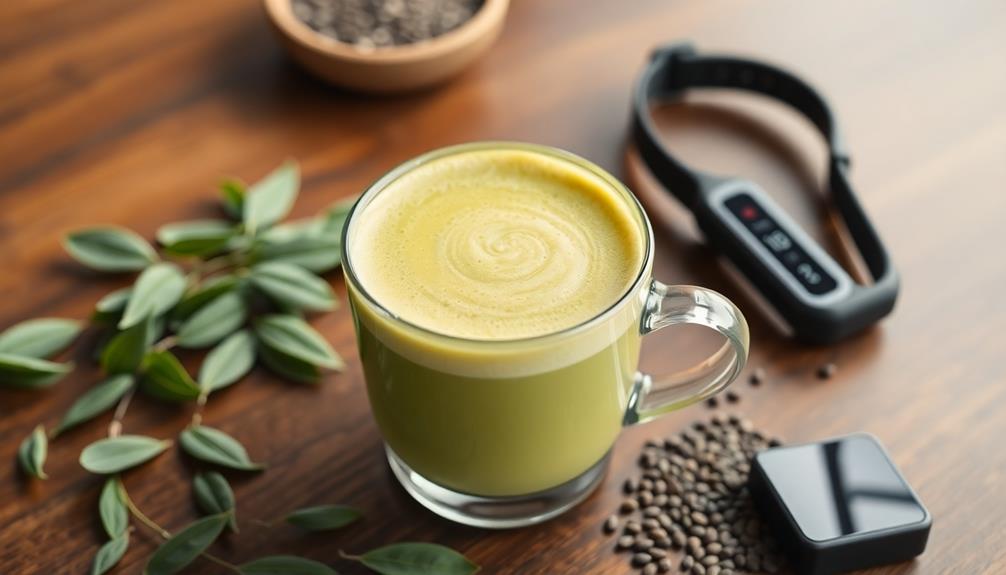
Top athletes are turning to alternatives like yerba mate, matcha, and even Mission for their energy boosts. These options provide a gentler caffeine experience without the jitters associated with coffee. Yerba mate offers sustained energy, while matcha promotes calm alertness. Mission stands out as a favorite, delivering slow-release energy that enhances performance without digestive issues. Athletes appreciate the focus and health benefits these non-coffee options provide. You'll discover more about how these alternatives can elevate your game and fit into a health-conscious lifestyle as you explore further.
Key Takeaways
- Yerba mate provides sustained energy with about 85 mg of caffeine, known for its immune-boosting properties, making it a popular alternative among athletes.
- Matcha tea offers a calm alertness with 25 mg of caffeine, recognized for its antioxidant benefits without the jitters associated with coffee.
- Guarana is a potent choice, containing up to 250 mg of caffeine per serving, enhancing focus and energy levels for elite athletes.
- Teeccino delivers a coffee-like flavor without caffeine, promoting gut health while providing community for non-coffee drinkers in the athletic world.
- Herbal teas are gaining traction for their health benefits, offering a caffeine-free option that supports enhanced focus and reduced anxiety during competitions.
Athlete Preferences for Coffee

For many elite athletes, coffee isn't just a morning ritual—it's an essential part of their training routine. Athletes like Abby Johnston and Evelyn Stevens down multiple cups daily, with Johnston averaging 3-4 cups each morning.
Shalane Flanagan, who rates her coffee addiction at 9/10, swears by its benefits for both mental and physical performance, similarly to how AI Ethicist Jobs shape the moral framework of technology. She typically enjoys her coffee 3-4 hours before races, believing it helps her focus and energize. However, she's careful with strong espresso, as it can sometimes lead to negative side effects if consumed too close to competition.
Coffee culture fosters camaraderie among athletes, with many sharing coffee rituals that build connections. You might find yourself bonding over a cup, discussing strategies or recent workouts.
Yet, it's important to remember that individual tolerance to caffeine varies greatly. While some athletes thrive on coffee, others, like Johnston's partner, might avoid it weeks before competitions due to its stimulating effects. This diversity in preferences highlights how coffee plays a multifaceted role in the lives of elite athletes, shaping not just their performance but also their social interactions.
Performance Impact of Caffeine
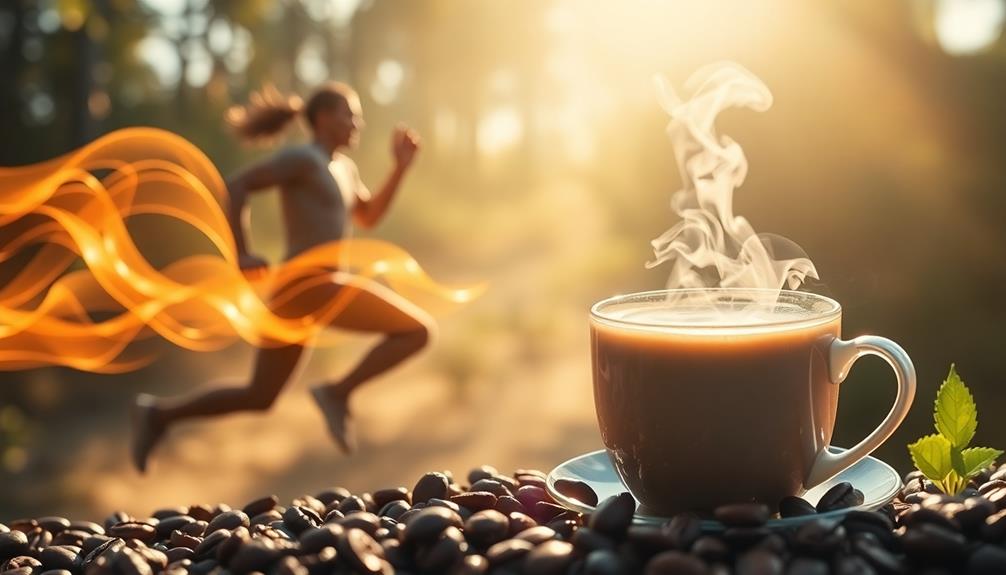
Athletes often see caffeine as a game-changer for their performance, with many claiming it sharpens focus and boosts alertness during both training and competition. The caffeine content in your pre-workout drink can greatly impact how you feel and perform.
For some, like Shalane Flanagan, coffee enhances mental performance more than physical, while Evelyn Stevens argues that sleep is the ultimate game-changer. Developing a growth mindset can also play a pivotal role in optimizing performance, as it encourages athletes to embrace challenges and learn from feedback, ultimately enhancing their training outcomes personal growth techniques.
Timing your caffeine intake is essential. Consuming strong espresso right before a race might backfire, causing overstimulation. This highlights the importance of knowing your own tolerance and reactions to caffeine.
Abby Johnston mentions that coffee helps maintain alertness during practice, but it can also lead to jitters for some athletes.
Many elite competitors report improved energy consistency and enhanced recovery when they opt for slow-release caffeine alternatives. These options help manage stress and anxiety, allowing you to focus on your performance without the crash often associated with high caffeine content.
In the end, understanding your body's response to caffeine can make all the difference in your training and competition results.
Travel Tips for Coffee Lovers

Traveling can be a challenge for coffee lovers, especially when you're trying to maintain your caffeine routine on the go. To avoid subpar coffee experiences, consider investing in a portable coffee maker like the AeroPress. Shalane Flanagan swears by it, ensuring she always has high-quality coffee no matter where she is.
Additionally, staying hydrated is essential, so consider incorporating juices, such as beet juice, which not only enhance stamina but can also provide a revitalizing alternative to coffee.
If you're traveling light, think about practical alternatives to traditional coffee-making gear. Evelyn Stevens opts out of packing coffee equipment to save weight, which can be a smart move for many travelers. Instead, look for local coffee shops or cafes that serve quality brews; the experience can enhance your trip and satisfy your coffee cravings.
Remember, coffee is more than just a drink; it's part of your routine and can foster camaraderie among fellow travelers, just as it does for athletes like Abby Johnston. Plan your journey around reliable coffee sources, prioritizing quality over convenience.
Lastly, if you can't find your favorite brew, consider packing a coffee substitute. These alternatives can help you keep your energy levels up while maintaining a semblance of your beloved coffee ritual on the road. Happy travels!
Timing Coffee Consumption

When it comes to coffee consumption, timing is everything for athletes like you. Proper awareness of your body's vibrational state can enhance your performance, as visualization techniques for peak performance can be complemented by strategic caffeine intake.
You might find that drinking coffee 3-4 hours before a race boosts your performance without causing jitters, while others may need to avoid it altogether in the weeks leading up to competition.
Understanding your own tolerance and strategizing your intake can make a significant difference in your performance.
Optimal Consumption Timing
Timing is essential for athletes looking to harness the benefits of coffee without facing its potential drawbacks. Shalane Flanagan suggests consuming coffee 3-4 hours before races to enhance performance. This timing helps you maximize the energizing effects of caffeine while minimizing any jitters that might hinder your focus and performance.
If you're someone who experiences shakes from caffeine, like Abby Johnston's partner, consider avoiding coffee weeks before competitions. Additionally, caffeine content in espresso can vary, so it's important to take note of the amount you're consuming.
Evelyn Stevens' experience highlights the significance of timing; she felt shaky during training but managed to avoid it during races. This shows that individual tolerance to caffeine varies greatly among athletes, so finding your ideal timing is fundamental.
You'll want to pay attention to how your body reacts to caffeine at different times, adjusting your consumption accordingly.
Ultimately, proper timing of coffee intake can enhance your energy levels and concentration without leading to overstimulation. Listen to your body, experiment with your coffee schedule, and find what works best for you. Remember, it's not just about consuming caffeine; it's about timing that consumption to reveal its full potential.
Pre-Race Coffee Strategies
Harnessing the power of coffee before a race can give you that extra edge, but knowing how to do it right is vital.
Timing your coffee consumption can greatly influence your performance, enhancing alertness while avoiding overstimulation. Incorporating strategies like monitoring your input lag essential for competitive gaming can also apply to how you time caffeine intake, ensuring you have ideal focus when it matters most.
Here are some effective pre-race coffee strategies:
- Consume coffee 3-4 hours prior to allow your body to metabolize caffeine without experiencing jitters.
- Choose a milder brew to prevent potential shakes that can occur with strong espresso.
- Monitor your individual reactions; some athletes, like Abby Johnston's partner, avoid coffee weeks before competitions to maintain steadiness.
- Experiment during training to find the ideal timing that keeps you focused and energized without adverse effects.
Individual Tolerance Variations
Understanding how your body reacts to caffeine is key to maximizing your performance. Timing your coffee consumption can greatly influence your results, as individual tolerance variations play a significant role. Some athletes thrive on caffeine, while others may experience jitters or shakes, particularly if consumed too close to competition.
Here's a quick overview of how timing affects different athletes:
| Athlete | Timing Recommendation | Response to Caffeine | Notes |
|---|---|---|---|
| Shalane Flanagan | 3-4 hours before races | Ideal performance | Avoids overstimulation |
| Abby Johnston's Partner | Weeks prior to competition | Experiences shakes | Personal tolerance limits |
| Evelyn Stevens | Varies by training vs. racing | Shakes in training only | Different conditions yield different responses |
| Flanagan (Espresso) | Avoid strong coffee close to races | Negative effects | Individualized timing is essential |
Insights From Non-Coffee Drinkers
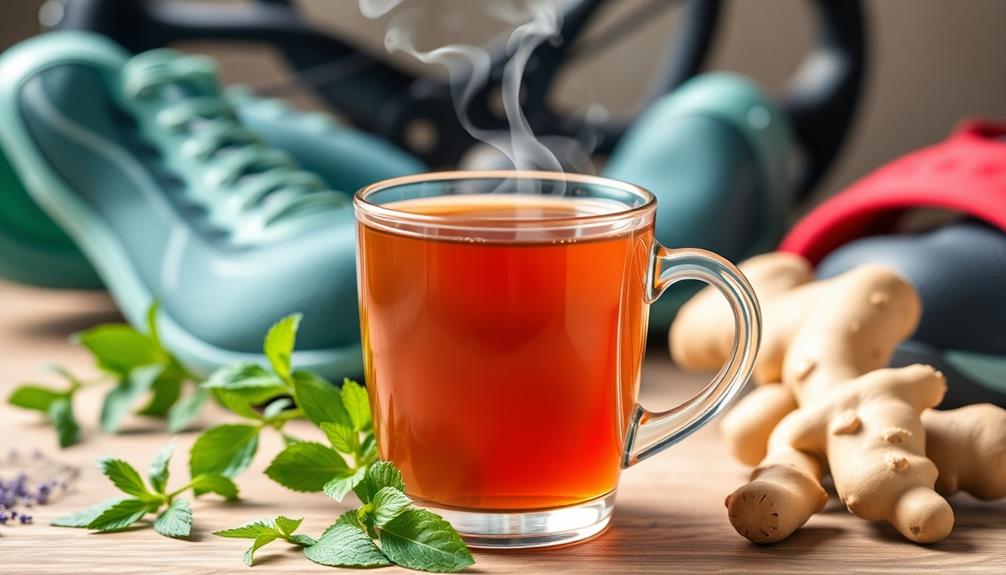
As a non-coffee drinker, you might find that there are plenty of alternative energy sources that can keep you fueled during intense training.
Many athletes prefer options like tea or natural energy drinks, which offer benefits without the jitters.
For instance, some athletes opt for fresh juice options that provide vitamins and minerals essential for performance.
Let's explore how these choices compare to the coffee culture that many of your peers embrace.
Benefits of Non-Coffee Options
Many elite athletes have discovered the remarkable benefits of choosing non-coffee alternatives, reporting enhanced focus and reduced anxiety during competitions. By steering clear of traditional coffee, they enjoy a more stable and consistent energy boost throughout the day, which helps them stay on top of their game.
Additionally, many athletes have turned to options like herbal tea, which is known for its calming effects and antioxidant properties, making it a popular choice among those looking for a gentle, revitalizing beverage unique flavors and benefits.
Here are some key benefits of non-coffee options:
- Gentler caffeine boost: Drinks like yerba mate and matcha tea provide a milder lift without overwhelming jitters.
- Health advantages: These alternatives often come packed with antioxidants and anti-inflammatory properties, supporting overall well-being.
- Better digestion: Options like Teeccino are acid-free and contain prebiotic fiber, promoting gut health without the side effects of coffee.
- Community connection: Non-coffee drinkers often share experiences, fostering camaraderie among athletes who prefer these alternatives for training and recovery.
Preferences Among Athletes
Athletes' preferences for beverages can reveal a lot about their routines and mindsets, especially when it comes to coffee. Many elite athletes, like Shalane Flanagan and Abby Johnston, express curiosity about non-coffee drinkers, viewing coffee culture as fundamental to their lives. Flanagan humorously suggests non-coffee drinkers might have other vices, while Johnston describes them as a "mystery," highlighting the common belief that coffee is crucial for energy and alertness.
Despite the allure of coffee, abstaining athletes risk missing out on the camaraderie and rituals that often accompany coffee consumption. Evelyn Stevens notes her surprise at those who don't drink coffee, reinforcing the notion that it's a significant part of many athletes' training and recovery.
Here's a quick look at preferences among athletes:
| Athlete | Coffee Preference | Thoughts on Non-Coffee Drinkers |
|---|---|---|
| Shalane Flanagan | Loves coffee | Finds them mysterious |
| Abby Johnston | Coffee lover | Curious about their energy source |
| Evelyn Stevens | Coffee enthusiast | Surprised by their choices |
Understanding these preferences opens a window into the diverse approaches athletes take toward maintaining their energy.
Exploring Alternative Energy Sources
How do non-coffee drinkers fuel their performance? Many elite athletes turn to alternative energy sources that provide the boost they need without relying on coffee. These options often come with added health benefits, making them appealing and effective.
For instance, some athletes incorporate essential oils for natural energy and recovery, harnessing the invigorating properties of essential oils for respiratory health to enhance their breathing and stamina during workouts.
Consider these popular alternatives:
- Matcha Tea: With 25 mg of caffeine, it's packed with antioxidants and promotes calm alertness.
- Yerba Mate: Delivering around 85 mg of caffeine per cup, it's known for immune-boosting properties and sustained energy.
- Dark Chocolate: With 12 mg of caffeine per ounce, it enhances mood and alertness while offering anti-inflammatory benefits.
- Guarana: This South American plant can pack up to 250 mg of caffeine per serving, making it a powerful focus enhancer.
Some non-coffee drinkers also lean towards products like Teeccino, which delivers a coffee-like flavor but is caffeine-free, promoting gut health through prebiotic soluble fiber.
These alternatives, along with energy drinks that harness natural ingredients, prove that there are plenty of ways to energize without a cup of coffee.
Finding your best fit can elevate your performance just like the pros!
Understanding Acrylamide Risks
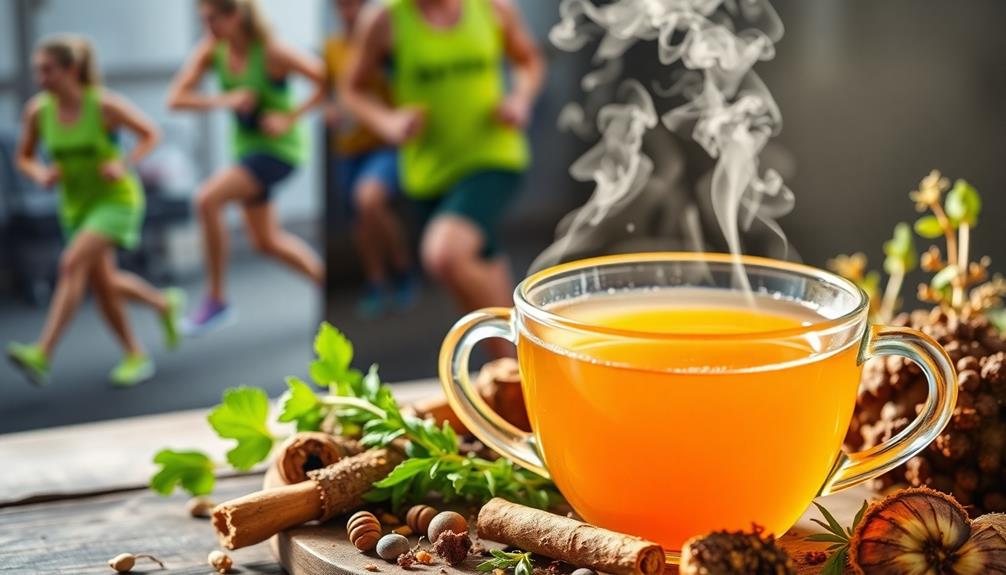
When considering coffee alternatives, it's crucial to be aware of acrylamide, a chemical that can form during high-temperature cooking processes. This compound often appears in starchy foods, including coffee and its substitutes, raising concerns about potential health risks, particularly cancer.
Research shows that acrylamide levels can vary considerably among products, and the FDA has identified Postum as having the highest acrylamide content by dry weight. Additionally, coffee's health benefits such as its antioxidants and potential disease risk reduction should be weighed against these concerns.
This revelation highlights the importance of monitoring acrylamide levels in food alternatives. While Postum has historically been marketed as a healthier option than coffee, the presence of acrylamide challenges that perception.
Ongoing research is focused on understanding the effects of acrylamide on human health and developing strategies to reduce its presence in food products.
To make informed choices, you can consult the FDA's extensive lists detailing acrylamide levels across various foods. By being proactive and aware of acrylamide risks, you can better navigate the landscape of coffee alternatives and choose options that align with your health goals.
Postum: A Historical Overview

Postum has a rich history that dates back to its introduction in 1895 as a caffeine-free coffee alternative made from roasted grain. With aggressive advertising, it quickly positioned itself as a healthier choice than traditional coffee.
Its popularity surged during World War II, when coffee was rationed, leading many consumers to seek out substitutes.
You can almost visualize the era with:
- Soldiers savoring a warm cup of Postum while chatting with friends.
- Families gathering around the kitchen table, sharing stories over this comforting beverage.
- Busy individuals enjoying the quick preparation of Instant Postum, launched in 1911, which catered to a demand for convenience.
- Fans of the drink chuckling at its quirky mentions in shows like "The Facts of Life" and "Seinfeld."
Cultural References to Alternatives
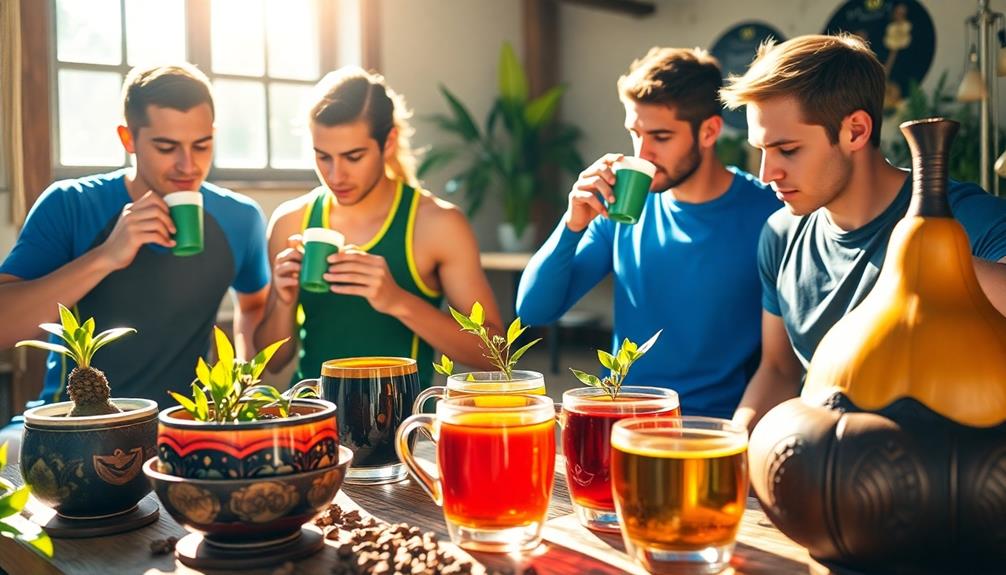
Cultural references to coffee alternatives like Postum highlight their unique place in society, especially during challenging times such as World War II. When coffee was rationed, Postum emerged as a popular substitute, reflecting the adaptability of consumers in the face of scarcity.
You might remember its mention in shows like "Seinfeld," where characters discussed this lesser-known beverage choice, indicating its cultural significance even in the domain of entertainment.
Similarly, Teeccino, a herbal coffee alternative, has gained appreciation for its rich flavor and health benefits. Many people, particularly those looking to reduce their caffeine intake, find value in maintaining the coffee experience without the jitters associated with traditional coffee.
This shift in preferences is a reflection of changing perceptions about caffeine consumption.
Moreover, elite athletes often share rituals around coffee, but many are turning to alternatives like herbal teas. They value these options for their perceived health benefits and the ability to enjoy a warm beverage without the downsides of caffeine.
As these alternatives gain traction, they reshape our understanding of what it means to enjoy a coffee-like experience.
Mission: The New Favorite
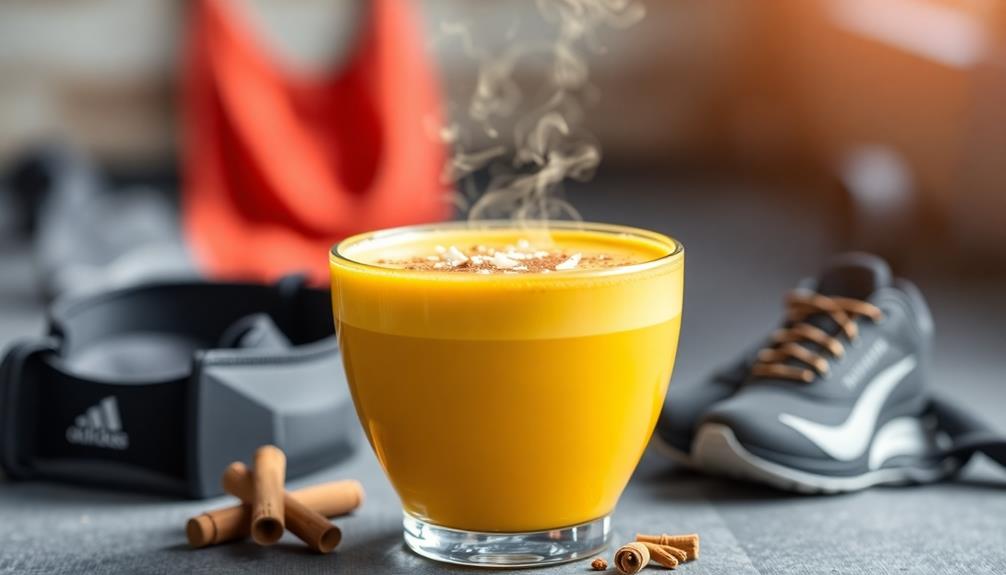
Over 100 international athletes and Premier League teams have made Mission their go-to choice for a slow-release energy alternative that enhances performance and recovery. This coffee replacement is revolutionizing how you think about energy drinks. Athletes rave about how it provides consistent energy without the jitters and digestive issues commonly associated with traditional caffeinated beverages.
Imagine waking up to:
- A revitalizing, eco-friendly drink that aligns with your health-conscious lifestyle
- A focused mind and heightened endurance during your toughest workouts
- Smooth recovery post-exercise, allowing you to train harder the next day
- The satisfaction of using a product recognized as Best Value Nutrition Drink of the Year
With its plastic-free tea bags and sustainable packaging, Mission fits perfectly into the dietary preferences of modern athletes.
Testimonials from elite performers highlight its incredible impact on their daily routines, making it a game changer. By switching to Mission, you're not just choosing a drink; you're opting for a performance-enhancing solution that supports your goals sustainably.
Frequently Asked Questions
What Is a Coffee Alternative for Athletes?
If you're looking for a coffee alternative, consider Teeccino. It's herbal, caffeine-free, and offers a rich flavor. You'll enjoy its pleasant aroma and gut-friendly benefits, perfect for any time without the jitters.
What Type of Coffee Is Good for Athletes?
When considering coffee for your training, opt for high-quality brews like single-origin beans. They enhance alertness and focus without overwhelming you. Just remember to time your consumption to avoid jitteriness before competition.
Do Elite Athletes Drink Coffee?
You won't believe it, but elite athletes practically live on coffee! They swear by it for energy, focus, and camaraderie. Many rely on those magical beans to enhance performance and bond over shared caffeine rituals.
What Was the Coffee Substitute in the 1970S?
In the 1970s, you'd find Postum as a popular coffee substitute. Its caffeine-free formula made from roasted grains appealed to health-conscious folks, promoting a wholesome lifestyle while providing a comforting alternative to traditional coffee.
Conclusion
In the world of athletes, finding the right fuel is essential, and while coffee's a classic go-to, alternatives like Postum are gaining traction. You might think of it as the new "superfood" in a time when nutrition's as critical as a knight's sword in battle. Exploring these options can enhance your performance without the jitters. So, whether you're sipping a warm cup or trying something new, remember: it's all about what works best for you on your journey to greatness.
In the vast and diverse world of coffee, coffee alternatives, and tea, Olivia has found her calling. As an author and a dedicated coffee and tea aficionado, her work for Cappuccino Oracle reflects her profound love and understanding of the intricate complexities found within these beverages. Olivia’s passion for the subject serves as both a catalyst for her creativity and a connection point with her audience.
Olivia’s appreciation for coffee, coffee alternatives, and tea blossomed at an early age. She discovered that these beverages invigorated her senses and stimulated her creative spirit. From the nuanced flavors of single-origin roasts to the captivating narratives intertwined with coffee, coffee alternatives, and tea trade and culture, Olivia found an unlimited source of inspiration in her daily cup.
Her love for these beverages and her talent for storytelling eventually converged at Cappuccino Oracle. As an author, Olivia’s mission is to illuminate the intricate tapestry that makes up the world of coffee, coffee alternatives, and tea. Her articles span a diverse range of topics, encompassing everything from the unique flavors of different brews to the sociocultural history intertwined with their cultivation and consumption.
-

 Coffee Basics4 days ago
Coffee Basics4 days agoThe Ultimate Guide To Buying Nespresso Pods: Where And How?
-

 Coffee Basics6 days ago
Coffee Basics6 days ago11 Best Medium Roast Coffees For Your Perfect Cup
-

 Coffee Basics6 days ago
Coffee Basics6 days agoStarbucks Venti Drinks: Customization And Pricing Guide
-

 Coffee Basics3 days ago
Coffee Basics3 days agoPerfect Your Espresso With Puck Screens: A Barista’s Secret
-

 Cappuccino Oracle Selected Reviews21 hours ago
Cappuccino Oracle Selected Reviews21 hours agoSmeg Knife Block Review Review [2024]
-

 Coffee Basics6 days ago
Coffee Basics6 days agoWhat Is Half-Caff Coffee? (And How Much Caffeine Is In It?)
-

 Coffee Basics6 days ago
Coffee Basics6 days ago9 Best Ground Coffee Brands For Your Perfect Cup
-

 Coffee Basics6 days ago
Coffee Basics6 days agoCan You Froth Oat Milk? Yes, And Here Are Six Ways To Do So















